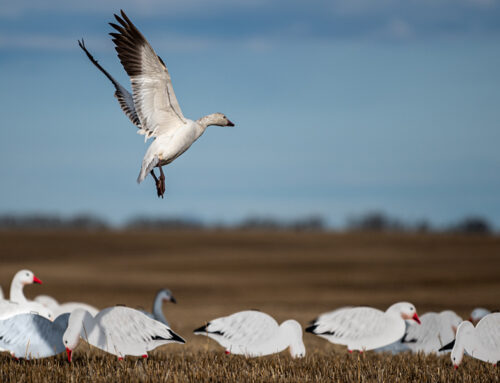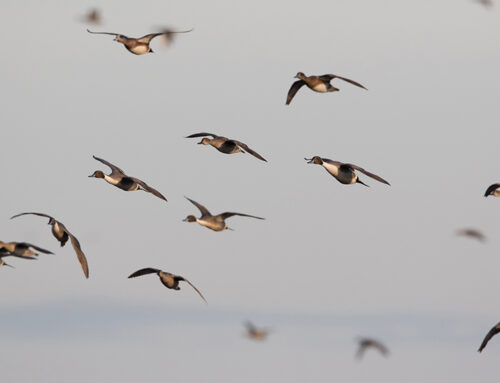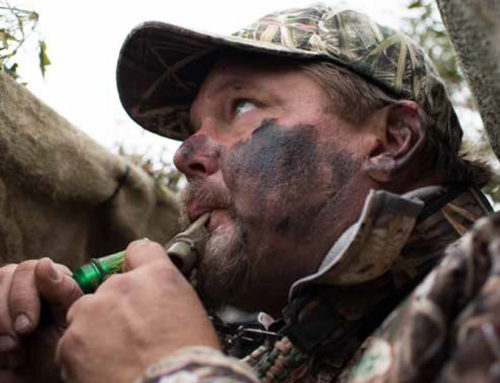How We Count Ducks
Accurate population estimates are critical to hunting regs and making ducks
By Bill Miller
Each August, North America’s waterfowl hunters anxiously count down the days awaiting publication of the USFWS Waterfowl Population Status Report. The report, and the resulting fall flight forecast by Delta Waterfowl incorporating actual monitored duck production and conditions through the summer months, offer excited hunters the best crystal ball in predicting what the hunting seasons ahead will hold.

Known to many as the “BPOP”, the survey is conducted annually in May and June by the U.S. Fish and Wildlife Service and the Canadian Wildlife Service. The aerial breeding surveys that evolved into the BPOP began in 1947, however, data are available beginning in 1955 when the survey became operational. The BPOP survey has been conducted every year since, except for 2020 and 2021, when they were canceled due to COVID-19 protocols.
While waterfowl hunters put a lot of stock in the analysis of the BPOP in predicting the waterfowl season ahead, its greatest impact on hunters is the fact that regulatory authorities use the BPOP—and other input—to determine season lengths and bag limit options as far as three years into the future. It’s truly important that it provide an accurate accounting of North American duck populations by consistent methodology from year to year.
The 2022 BPOP, released on August 22 of this year, reports the North American population of breeding ducks was 34.2 million plus or minus 0.6 million birds. However, that does not mean a group of human beings laid eyes on between 33.6 and 34.8 million ducks.
By any method, counting ducks is more accurately called estimating, surveying or indexing ducks.
Delta waterfowl scientist Dr. Chris Nicolai said, “It’s not like taking a census in which each duck would be individually accounted for. That’s not practical or possible. Instead, the ways ducks are counted are through carefully-conducted, long-established surveys that are then input into many scientific formulas that produce statistically accurate estimates of populations. The most important thing they reveal are trends which are comparisons to averages of previous counts.”
This is why Delta’s reporting on the BPOP and individual state surveys always includes an analysis of the current estimated breeding population compared to both the previous year’s survey estimate and the LTA (or long-term average). In the case of the BPOP, that’s the average estimated population all the way back to the survey’s beginning in 1955—65 years (with the two lost to COVID-19) and counting.
Breaking Down the BPOP

Some BPOP data is collected on the ground, but it’s primarily gathered in the skies via airplanes and helicopters. In total, BPOP surveys cover more than 2 million square miles encompassing the principal breeding areas of North American ducks. The core of that region is the prairie potholes and the Canadian parklands.
“The majority of the surveys are done from fixed-wing aircraft with a pilot and an observer, both looking for and recording sightings of waterfowl and the number of ponds,” said Nicolai. “Usually, it’s the pilot watching out the left side of the plane and the observer watching out of the right side. They are looking out one-eighth of a mile and recording all of the ducks they see.”
The planes are flying repeated, precisely established routes known as transect lines. For accurate data, it’s vital that they fly precisely the same route season after season under conditions as similar as possible year after year.
Nicolai said, “The planes fly along 16-mile segments of the transects at an altitude of 100- 200 feet, but as close to 100 feet as possible. The pilot and observer each have a special recorder with a microphone. When birds are spotted, the one who sees them clicks the microphone and states the number, sex, species and pair status of the birds. The keying of the mic automatically cues the recorder to plot the exact waypoint at which the observation was made.”
Over thousands of flights and hundreds of thousands of miles of transects flown each year, the result is a mountain of digital data that needs to be analyzed, which is a major reason why even though the surveys are taken in May and June the results are not released until nearly September.
“The most accurate data comes from consistency,” said Nicolai. “That’s why the agencies do their best to keep the same pilots and same observers on the same survey areas year after year if at all possible. Each year, they also verify some areas with ground crews, where it’s possible, traveling by road.”
When the raw numbers from all the surveyors in all the survey areas are in, they are loaded into formulas that allow the agencies to factor in the conditions under which the counts were conducted.
“Using a variety of methods, they developed ‘visibility correction factors’ in the 1990s for every single stratum,” said Nicolai. “Some portions of the survey areas are rechecked for these correction factors every year, but in the remote areas, they consistently use those developed 30 years ago.
“In any case, these factors allow them to multiply what the airplane sees by a number to account for the ones they missed. For example, they know they barely miss any canvasbacks, because they are bright white and pretty much out in the open. But then green-winged and cinnamon teal are little, dark and really like to hide up in the vegetation. In some areas they’ll actually multiply those species by 10.”
As thorough as the surveys try to be, factors can change from season to season. For example, the right-seat observer may count ducks differently than last year’s right-seat observer; the phenology may be unusual in a given year; the time of day flown might vary, changing the angle of the sun on the water; or a cloudier day may have made it easier to spot ducks. All of these factors and more can impact the precision and consistency of the survey from year to year. Correction factors attempt to account for that.

Once the data are collected and the correction factors are applied, that’s when the survey results are tallied and ultimately issued to the public by the USFWS. However, it’s important for hunters to remember: That number of 34.2 million ducks (plus or minus 0.6 million) is the estimate of the breeding stock returned to the breeding grounds in May and June. The migrating birds we hunt 3-5 months later in the fall flight include the breeding duck survey estimate plus their offspring.
Delta Waterfowl’s work is first and foremost focused on optimizing the production success of the birds counted in the spring to create the largest fall flights possible. Delta has proven time and again that it’s what happens on the breeding grounds in May, June, and July that has a 90 percent impact on the population of the birds that fly south and those that return the following spring.
Lincoln Logs
You may think that programs such as the USFWS Waterfowl Parts Collection Survey (sometimes called the “Wingbee Survey”), the Diary Survey, the Hunter Information Survey you must take when buying your migratory bird hunting license, and waterfowl banding and recovery analyses are only used in estimating the annual harvest of ducks, geese and other migratory birds. However, scientific methods have been developed that incorporate the data collected by these surveys to calculate reproduction rates and populations.
A population counting system called the Lincoln Estimator uses banding data and the wingbee and diary survey data to estimate how many ducks there were at banding.
Nicolai said, “The Lincoln Estimator is like figuring how to estimate how many beans are in a jar. Say somebody has a big old jar full of beans at a charity event. You buy a ticket to make your guess and whoever is closest wins the side of beef.
“So the way we do it with ducks is imagine you have that jar of beans. You grab as big a fistful of beans as you can and you put a little Sharpie marker tick on each one of them and you carefully count them as you do. Then you put them back in the jar and shake it up really good. That’s banding and releasing the ducks back into the flock.
“So you let the banded ducks go, they fly around, migrate and just go and do what ducks do.
“Then awhile later you go back to the jar and grab another big fistful of beans. You carefully count them again, making sure you keep track of how many of them have a tick mark on them and how many don’t. From that, you get a marked to unmarked ratio.
“With the ducks, that second fistful you pull represents hunting season. The tick marked beans represent the harvested ducks with bands that were reported. And you get the total harvest estimate from the number of wings submitted and the diary survey—which is represented by the total count of beans in that second fistful.
“Finally, you apply the ratio of banded to non-banded birds in the harvest to the total number of birds you banded and the result is an estimate of the total population … or the total number of beans in the jar.”
To put easy numbers to it, let’s say you had 1,000 beans in your first fistful. You mark them all. You put them back, mix them in thoroughly and pull the second handful. Let’s say you got a really big handful the second time and got 2,500 beans. You separate the marked beans from the unmarked and find you have 75 marked beans and 2,425 unmarked beans. Applying that ratio to the 1,000 marked beans (banded ducks) you would estimate that there were 32,333 beans in the jar and win yourself that delicious supply of beef!
Unfortunately, reporting of banded ducks taken and voluntary submission of harvested duck and goose wings and diary logs are not nearly as precise as counting a few pinto beans.

Incompatible Surveys
Specific counts and estimating systems work well and are accurate gauges of population trends when you realize how they are constructed and are used for their intended purposes. However, problems arise when you start mixing and matching results from multiple kinds of surveys. That’s when wild and inaccurate conclusions are reached.
Nicolai said, “The problem comes up when you use two different counts in the same analysis. The BPOP or anything else is not a census. It’s an estimate that’s probably biased somehow. When the biases are consistent from year to year, you can look at trends and relative changes. But if you use something like BPOP and the harvest estimate, they’re on different scales. One duck doesn’t equal one duck. It’s a total unknown, but it could be like 10 ducks in the BPOP equal to one duck in the harvest survey. And that’s where folks run into problems.
“Say we wanted to look at what percentage of ducks get shot every year, and if you took the harvest survey and divided it by the BPOP, that wouldn’t work … you have to remember the BPOP survey doesn’t include all of North America, but the harvest survey does. And that’s just one example.”

The Final Analysis
All of the surveys and analyses used to monitor waterfowl populations are important, and each has its place for specific purposes. Trained, professional wildlife management scientists, like those engaged in research, education and duck production at Delta, know exactly how to overlay these data sets to determine exactly where best to enact practices like Predator Management and Hen Houses. They also are able to determine which areas and species need more study and offer important views when it comes to setting regulations for future seasons.
And for supporters of The Duck Hunters Organization, its Delta’s expertise at interpreting the various survey results that provide the forecast for the great season ahead.
Bill Miller is director of communications for Delta Waterfowl.
Surveys That Answer
“Are They Here Yet?”
Surveys like the BPOP and those relying in some way on harvest data don’t provide the information hunters are looking for during the season. BPOP is a spring count, and harvest data come after the season is over. Hunters most often want to know how many ducks are in their hunting location today, tomorrow or next week.
Most often, such counts rely on what Dr. Chris Nicolai, Delta’s waterfowl scientist, calls “cruise surveys.” A refuge manager or WMA technician either flies over the area, drives the roads or levies with binoculars, or takes a boat out onto a bay with binoculars and attempts to count waterfowl.
Nicolai said, “They are trying to do the best they can, but usually these kinds of estimates in an isolated area are based on physically counting a mass of birds spotted from the air, ground or water. It’s generally a matter of counting a portion of the visible birds, estimating what portion—a tenth, a twentieth, whatever—of the raft you’ve counted, doing the multiplication, and taking your best guess. Again, it’s consistency that helps the most. A veteran manager who has been out there season after season counting birds in the same locations, in the same way, will offer the best estimates, because their prognostications at least are relative to the ones they’ve made before.”
This is the same advice offered to hunters in making realistic estimates of the birds when scouting. For example, try to imagine a grid over a flock of snow geese in a field. You can try to use distant landmarks between which to draw imaginary lines. Then use your binoculars to count the birds in one sector of the grid. Multiply the count by the number of sectors in the grid and the result is your estimate.
For the hunter lying in a layout blind watching ducks or geese stream overhead from horizon to horizon, divide by time. Try to count the number of birds flying overhead for five minutes for example. Make note of it, let some time pass and count for another five minutes. After doing this several times, average the counts, then multiply by the length of time the birds were flying. So, if you were averaging 100 birds in every five-minute segment, and they’d been flying for an hour, you can estimate you saw 1,200 birds.
It may not be truly scientific, but back at camp, it’s a lot easier to convince your buddies if you’ve got “the math” to back you up! — Bill Miller





Leave A Comment